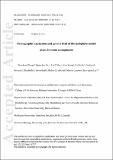Files in this item
Demographic expansion and genetic load of the halophyte model plant Eutrema salsugineum
Item metadata
| dc.contributor.author | Wang, Xiao-Juan | |
| dc.contributor.author | Hu, Quan-Jun | |
| dc.contributor.author | Guo, Xin-Yi | |
| dc.contributor.author | Wang, Kun | |
| dc.contributor.author | Ru, Da-Fu | |
| dc.contributor.author | German, Dmitry A. | |
| dc.contributor.author | Weretilnyk, Elizabeth A. | |
| dc.contributor.author | Abbott, Richard J. | |
| dc.contributor.author | Lascoux, Martin | |
| dc.contributor.author | Liu, Jian-Quan | |
| dc.date.accessioned | 2019-06-21T23:41:17Z | |
| dc.date.available | 2019-06-21T23:41:17Z | |
| dc.date.issued | 2018-07 | |
| dc.identifier | 253291241 | |
| dc.identifier | fbbf8884-7109-4810-b50b-bb2b8fb64054 | |
| dc.identifier | 85049783894 | |
| dc.identifier | 000438352500004 | |
| dc.identifier.citation | Wang , X-J , Hu , Q-J , Guo , X-Y , Wang , K , Ru , D-F , German , D A , Weretilnyk , E A , Abbott , R J , Lascoux , M & Liu , J-Q 2018 , ' Demographic expansion and genetic load of the halophyte model plant Eutrema salsugineum ' , Molecular Ecology , vol. 27 , no. 14 , pp. 2943-2955 . https://doi.org/10.1111/mec.14738 | en |
| dc.identifier.issn | 0962-1083 | |
| dc.identifier.other | crossref: 10.1111/mec.14738 | |
| dc.identifier.uri | https://hdl.handle.net/10023/17945 | |
| dc.description | This work was supported by National Natural Science Foundation of China (31590821, 91331102, 91731301) and the Youth Science and Technology Innovation Team of Sichuan Province (2014TD003). | en |
| dc.description.abstract | The halophyte model plant Eutrema salsugineum (Brassicaceae) disjunctly occurs in temperate to subarctic Asia and North America. This vast, yet extremely discontinuous distribution constitutes an ideal system to examine long‐distance dispersal and the ensuing accumulation of deleterious mutations as expected in expanding populations of selfing plants. In this study, we re‐sequenced individuals from 23 populations across the range of E. salsugineum. Our population genomic data indicate that E. salsugineum migrated ‘out of the Altai region’ at least three times to colonize northern China, northeast Russia and western China. It then expanded its distribution into North America independently from northeast Russia and northern China, respectively. The species colonized northern China around 33.7 thousand years ago (kya) and underwent a considerable expansion in range size approximately 7‐8 kya. The western China lineage is likely a hybrid derivative of the northern China and Altai lineages, originating approximately 25‐30 kya. Deleterious alleles accumulated in a stepwise manner from (i) Altai to northern China and North America, and (ii) from Altai to northeast Russia and North America. In summary, E. salsugineum dispersed from Asia to North America and deleterious mutations accumulated in a stepwise manner during the expansion of the species’ distribution. | |
| dc.format.extent | 1568818 | |
| dc.language.iso | eng | |
| dc.relation.ispartof | Molecular Ecology | en |
| dc.subject | Eutrema salsugineum | en |
| dc.subject | Migration | en |
| dc.subject | Hybrid lineage | en |
| dc.subject | Long-distance dispersal | en |
| dc.subject | Expansion | en |
| dc.subject | Deleterious variant | en |
| dc.subject | QH301 Biology | en |
| dc.subject | DAS | en |
| dc.subject.lcc | QH301 | en |
| dc.title | Demographic expansion and genetic load of the halophyte model plant Eutrema salsugineum | en |
| dc.type | Journal article | en |
| dc.contributor.institution | University of St Andrews. School of Biology | en |
| dc.identifier.doi | 10.1111/mec.14738 | |
| dc.description.status | Peer reviewed | en |
| dc.date.embargoedUntil | 2019-06-22 |
This item appears in the following Collection(s)
Items in the St Andrews Research Repository are protected by copyright, with all rights reserved, unless otherwise indicated.

